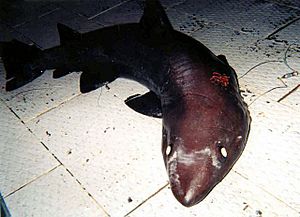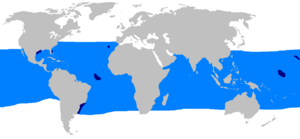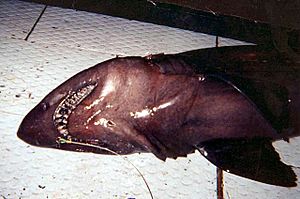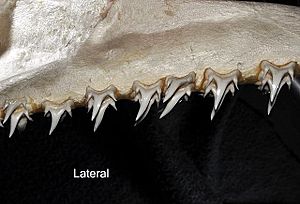Bigeye sand tiger facts for kids
Quick facts for kids Bigeye sand tiger |
|
|---|---|
 |
|
| Conservation status | |
| Scientific classification | |
| Genus: |
Odontaspis
|
| Species: |
noronhai
|
 |
|
| Confirmed (dark blue) and suspected (light blue) range of the bigeye sand tiger | |
| Synonyms | |
|
Carcharias noronhai Maul, 1955 |
|
The bigeye sand tiger (Odontaspis noronhai) is a very rare type of mackerel shark. It belongs to the sand tiger shark family and might live all over the world. This shark is quite large and bulky, growing to at least 3.6 m (12 ft) (about 12 feet) long. It has a long, rounded snout and big, orange eyes. Its mouth is wide, showing off its narrow, sharp teeth.
You can tell the bigeye sand tiger apart from its close relative, the smalltooth sand tiger (O. ferox), by its teeth. The bigeye sand tiger has only one small point (called a cusplet) on each side of its main tooth point. It also has a solid dark brown color all over. This shark lives in deep ocean waters, usually between 60–1,000 m (200–3,280 ft) (about 200 to 3,300 feet) deep. It probably moves up and down in the water and travels across the ocean. It eats bony fish and squid. Its big eyes and dark color suggest it spends most of its time in the deep, dimly lit parts of the ocean.
Like other mackerel sharks, the bigeye sand tiger likely gives birth to live young. The baby sharks probably feed on unfertilized eggs inside their mother. This shark is sometimes caught by accident by fishing boats, but this happens very rarely.
Contents
Discovering the Bigeye Sand Tiger
The first bigeye sand tiger shark known to science was a female, about 1.7 m (5.6 ft) (5.6 feet) long. It was caught in April 1941 near the Madeira Islands. A German fish scientist named Günther Maul described this shark in 1955. He named the species noronhai to honor Adolfo de Noronha, who was the director of the Funchal Museum.
At first, this shark was placed in the Carcharias group, which included all sand tiger sharks. Later, scientists realized that Odontaspis was a separate group. Because the bigeye sand tiger looks a lot like the smalltooth sand tiger (O. ferox), it was moved to the Odontaspis group. For a while, some scientists wondered if the bigeye sand tiger was just a very unusual version of the smalltooth sand tiger. Other common names for this shark include black sand tiger and bigeye ragged-tooth shark.
What Does the Bigeye Sand Tiger Look Like?
The bigeye sand tiger has a heavy body, a cone-shaped snout, and a large mouth with teeth that stick out. It looks quite similar to the more famous sand tiger shark. Its large eyes do not have the special eyelids (nictitating membranes) that some sharks have. Behind its eyes are small holes called spiracles. The corners of its mouth reach back past its eyes, and its jaws can push forward a lot.
This shark has many rows of teeth: 34–43 rows in the upper jaw and 37–46 in the lower jaw. Each tooth has a narrow, pointed main tip with one smaller point on each side. This is different from the smalltooth sand tiger, which has two or three smaller points on each side of its teeth. The bigeye sand tiger has five pairs of gill slits.
Its pectoral fins are medium-sized and wide with rounded ends. The first dorsal fin (the one on its back) is large and rounded. It is closer to the pectoral fins than to the pelvic fins. The second dorsal fin is about half the size of the first. The pelvic fins are almost as big as the first dorsal fin. The anal fin is smaller than the second dorsal fin and is located behind it. The tail fin has a short lower part and a long upper part with a deep notch near the tip.
The shark's skin is covered in tiny, overlapping scales called dermal denticles. Each denticle has three ridges. The bigeye sand tiger is usually a plain dark reddish-brown or chocolate brown color. Sometimes, its fins have black edges, or its first dorsal fin has a white tip. Its eyes are dark orange with oval, green-tinted pupils. Inside its mouth, there are several black patches. The largest male sharks found were 3.6 m (12 ft) long, and the largest females were 3.3 m (11 ft) long.
Where Do Bigeye Sand Tigers Live?
Even though they are very rare, bigeye sand tigers have been found in different places around the world. This suggests they might live in many separate areas across tropical and warm-temperate ocean waters. Most sharks found have been in the Atlantic Ocean, near Madeira, southern Brazil, Texas, eastern Florida, and the Mid-Atlantic Ridge.
There's also some evidence they might be in the Indian Ocean, possibly near the Seychelles, or even the South China Sea. In the Pacific Ocean, scientists first suspected their presence in 1970 from teeth found in ocean sediments. This was confirmed later by sharks caught near the Marshall Islands and Hawaii.
Bigeye sand tigers have been caught at depths from 60 and 1,000 m (200 and 3,280 ft) (about 200 to 3,300 feet). Some were found near the ocean floor over continental shelves, while others were swimming in the open ocean where the water was 4.5–5.3 km (2.8–3.3 mi) (about 2.8 to 3.3 miles) deep. Sharks caught at shallower depths at night suggest they might swim up from deeper waters to feed when it's dark. In Brazil, these sharks are only caught in spring, which could mean they have a seasonal migration.
Bigeye Sand Tiger Habits and Diet
One bigeye sand tiger that was caught alive was very aggressive, thrashing and snapping wildly. Its large eyes and dark color are common features of fish that live in the deep, dimly lit parts of the ocean. The bigeye sand tiger eats bony fish and squid.
Not much is known about how they reproduce, but it's likely similar to other mackerel sharks. They give birth to live young, and the baby sharks probably eat unfertilized eggs inside their mother's uterus during development. Adult female sharks have one working ovary (on the right side) and two working uteruses. Male sharks become adults when they are between 2.2 and 3.2 m (7.2 and 10.5 ft) (7.2 to 10.5 feet) long, and females mature at about 3.2 m (10 ft) (10.5 feet) long. Scientists don't have much information on how fast they grow or how long they live.
Bigeye Sand Tigers and Humans
Because the bigeye sand tiger is so rare, it's not important for commercial fishing. It is sometimes caught by accident in fishing nets or on longlines. However, because so few are caught, it seems they mostly live in waters too deep for most fishing boats.
The International Union for Conservation of Nature (IUCN) has listed this species as Data Deficient. This means there isn't enough information about its biology or population numbers to know if it's endangered. Since 1997, the National Marine Fisheries Service in the United States has made it illegal to catch this shark in U.S. waters.
See also
 In Spanish: Odontaspis noronhai para niños
In Spanish: Odontaspis noronhai para niños






